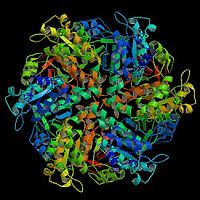
Photo from wikipedia
Luteolin is a flavonoid compound derived from Lonicera japonica Thunb, which has been reported to exert anticancer effects on different types of tumors. miRNAs are a kind of endogenous non-coding… Click to show full abstract
Luteolin is a flavonoid compound derived from Lonicera japonica Thunb, which has been reported to exert anticancer effects on different types of tumors. miRNAs are a kind of endogenous non-coding small RNAs, which involved in occurrence and development of multi cancer, including miR-34a. However, the relationship between miR-34a and luteolin's susceptibility to cancer cells still remains unclear. In this study, we explored the roles of miR-34a and the effects of luteolin on GC cells as well as the underlying mechanism of miR-34a in mediating the susceptibility of GC cell to luteolin. Retrospectively study revealed that miR-34a expression was downregulated in human primary GC tissues compared with non-tumor tissues and low miR-34a expression was associated with a significantly shorter overall survival and disease-free survival. MiR-34a overexpression could inhibit GC cells and induce G1 phase arrest via p53/p21 and MAPK /ERK pathways. Luteolin decreased viability of GC cells in a dose-dependent manner. Meanwhile, miR-34a was found to be markedly upregulated in GC cells induced by luteolin and decreased miR-34a level was found in the artificial luteolin-resistant GC cells. Upregulation of miR-34a in luteolin-resistant GC cell could enhance the sensibility of GC cells to luteolin. On the other hand, miR-34a inhibitor could partly counter the anticancer effect of luteolin. In a further assay, we also found that targeting miR-34a could mediate the susceptibility of mouse xenografts to luteolin. Subsequent study found that HK1 was a direct target of miR-34a and downregulated HK1 mRNA or protein levels were presented after miRNA-34a overexpression in GC cells. Moreover, HK1 protein levels was decreased after luteolin treatment and partly restored when co-treated with luteolin and miR-34a inhibitor. Downregulation of HK1 in luteolin-resistant GC cell could increase the cell's sensitivity to luteolin. Therefore, our findings firstly suggested that miR-34a could modulate the susceptibility of gastric cancer cell to luteolin via targeting HK1, potentially benefiting GC patients' treatment in the future.
Journal Title: Gene
Year Published: 2018
Link to full text (if available)
Share on Social Media: Sign Up to like & get
recommendations!